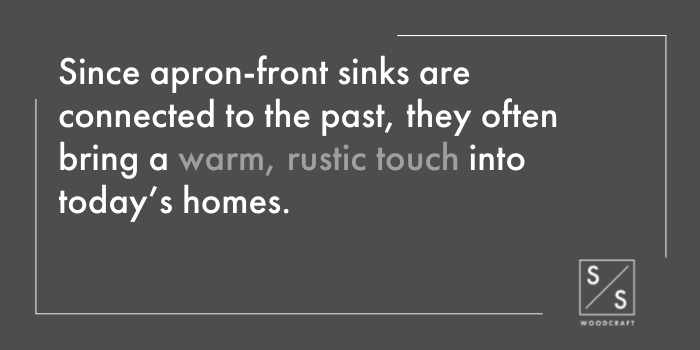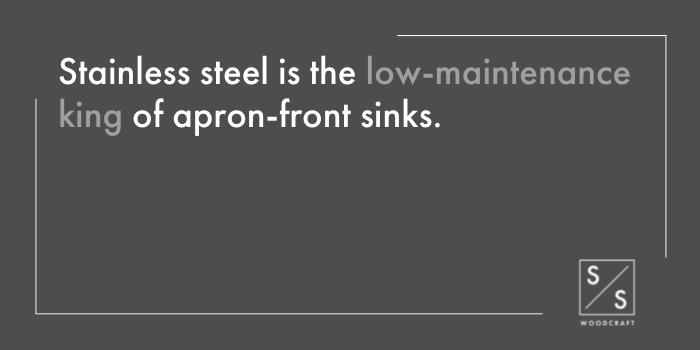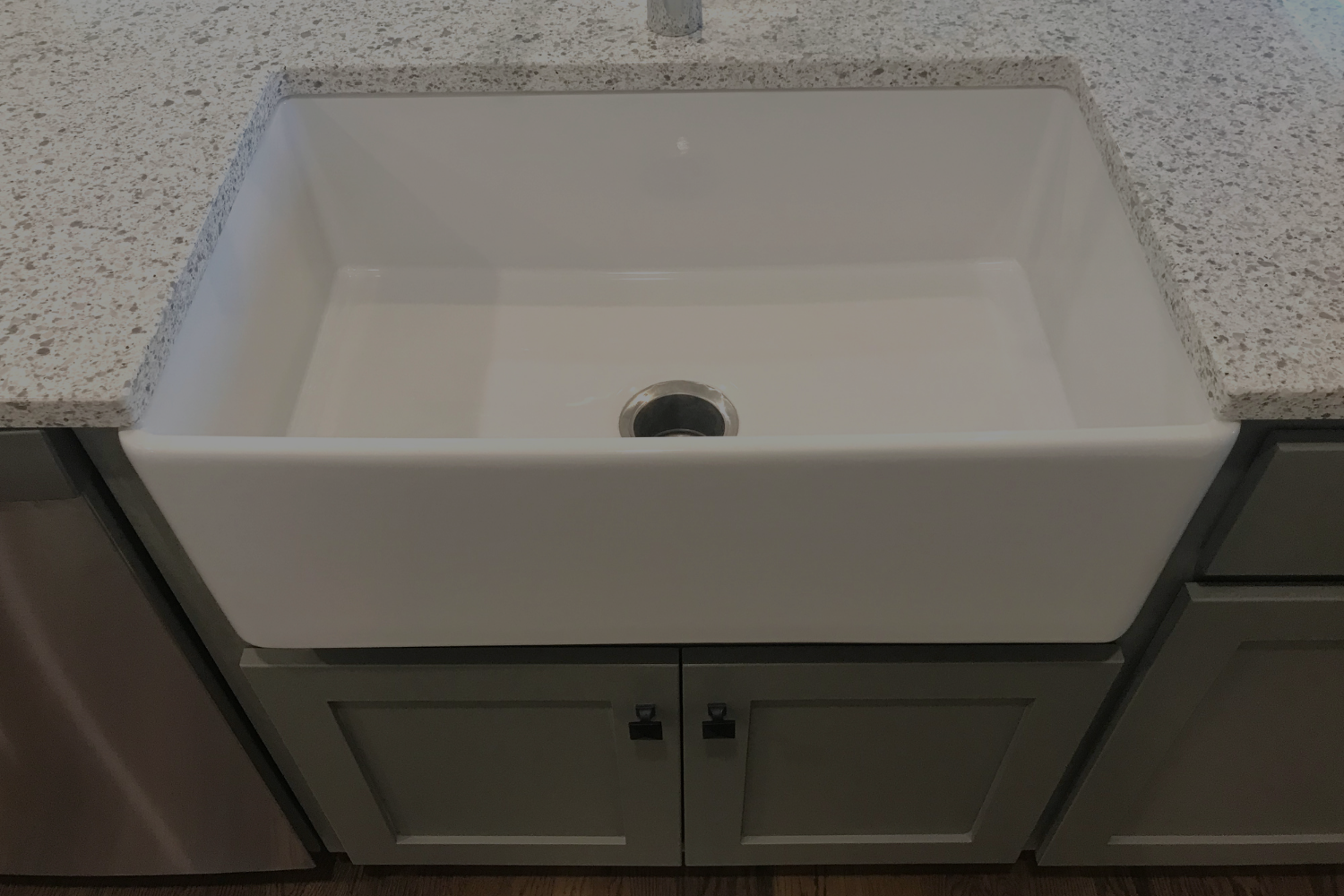Is the Farmhouse Sink Fad Right for You?
September 17, 2021Apron-front sinks (also called farmhouse sinks) are making an appearance in kitchens everywhere, from Cold Lake to California. Whether your style is modern or rustic, they fit right in. The design is versatile, the materials are unique, and the possibilities are endless.
Not sure what an apron-front sink is? It’s a sink that slides over your cabinets and under your countertops. The front of the sink is left exposed and acts as a visual highlight piece for your kitchen. Typically, apron-front sink basins are deeper and wider than traditional sinks, making them both beautiful and highly functional. They’re usually a single, large basin but can also be a double-basin.
Farmhouse sinks are popular, but are they worth the investment? Learn about materials and design options for this sink, as well as how to maintain it so it lasts for years in your home.
The History of Farmhouse Sinks
Farmhouse sinks were designed to be convenient. They slide easily under the countertop and aren’t attached to a faucet, which means the sink is easy to replace if it gets damaged. This was helpful in the past when farmhouse sinks were used by people who didn’t have easy access to running water. Double-basin farmhouse sinks could be filled up with water on one side for doing laundry or washing dishes. When the sink needed replacing, it was easy to take it out and reinstall a new sink.
Since apron-front sinks are connected to the past, they often bring a warm, rustic touch into today’s homes. That said, they still can find a place in modern kitchens.

Material: Choosing Between Ceramic and Stainless Steel
Ceramic and stainless steel are two of the most popular materials for farmhouse sinks. We’ll go over the differences in the look and the maintenance so you can choose the correct material for your kitchen.
The Look
If you want your apron-front sink to fit in with a more rustic, warm kitchen, ceramic is a great material to consider. Ceramic sinks are often white, but they come in other colours, too (light and dark grey ceramic sinks fit well into a more modern kitchen).
A stainless steel apron-front sink is a great option for homeowners who want the form and function of this type of sink, but aren’t as fussed about the rustic look. Stainless steel is easy to care for and lasts a long time with minimal maintenance.
Specialty Options
There are several specialty materials you can use for your farmhouse sink, like copper, granite, basalt, or marble. These will run more expensive than the other varieties, but if you’re looking for a stand-out centerpiece for your kitchen, these materials might be an interesting option for you.
Maintaining Your Apron-Front Sink
Each sink material will need slightly different care. Some of our top tips include:
Maintaining Ceramic
Ceramic sinks hold up fairly well to daily use as long as their sealant is intact. Unfortunately, several common kitchen products can slowly chip away at ceramic sealant, including most chemical cleaners.
To keep your ceramic in good shape, you’ll need to use gentle, natural cleaning products. Also make sure to quickly rinse substances like coffee, wine, and tomato juice out of your sink basin right away. If your sealant isn’t in tip-top shape, your ceramic will stain quickly.
Maintaining Stainless Steel
Stainless steel is the low-maintenance king of apron-front sinks. They never need to be resealed, and they hold up to almost any kitchen product or substance. Feel free to pour anything into it, and keep it clean with the product of your choice.

Maintaining Specialty Materials
If you select a specialty material for your sink, like copper or natural stone, your care guidelines will be different. Copper sinks develop patterns in their patina over time as certain substances begin to strip it away. Acidic foods (like the ones we mentioned above), cosmetics, and chemicals can affect the look of the patina.
Keep in mind, these materials don’t directly damage the copper - they just influence the look of your sink. Some homeowners really like the way their copper patina ages over time and choose the material for this reason.
Natural stone care will differ depending on which stone you choose for your sink. Consult your contractor for guidance on how to take care of different types of natural stone.
Single vs. Double-Basin
Apron-front sinks come in both single and double-basin varieties. Single-basin sinks are having a moment in the design world right now. Often, single-basin sinks feel roomier and fit better into certain kitchen designs. They make dishwashing easy, especially if your sink has a dishwasher right next to it. 
Double-basin sinks originally existed so you could fill one half with soapy water for dishwashing and laundry. Nowadays, some homeowners don’t feel the need for this feature, since they have access to a dishwasher and a laundry machine. If you don’t have a dishwasher, however, consider the double-basin sink for some added convenience.
Are There Drawbacks to an Apron-Front Sink?
When choosing a sink for their new kitchen, some homeowners worry that the exposed front of the farmhouse sink causes an extra cleaning hassle. We commonly get questions about extra drippage damaging the cabinets below. In our experience, apron-front sinks usually don’t present any unique problems with extra maintenance. They tend to age just the same as any other inset sink.
Is a Farmhouse Sink the Right Option for You?
Apron-front sinks have a long history in homes for a reason — they’re a versatile option for almost any lifestyle or kitchen design. If you think a farmhouse sink is the right option for you (or if you’d like to learn about other sink options), contact us for a design appointment. We’d love to discuss your ideas for your new sink and kitchen!
.png)


